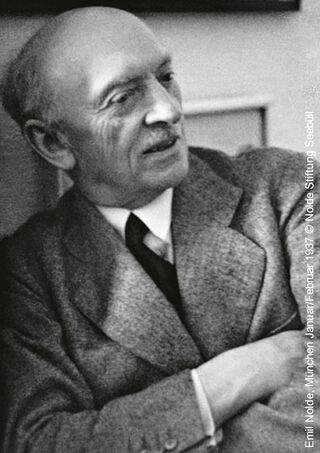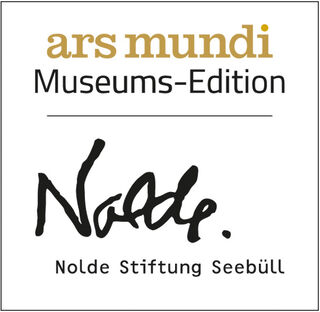Set of 4 champagne glasses "Summer Flowers"
Set of 4 champagne glasses "Summer Flowers"
Quick info
ars mundi Exclusive Edition | signature | glass | height 23 cm each | capacity 0.21l each | hand wash recommended | only as a set
Detailed description
Set of 4 champagne glasses "Summer Flowers"
Exclusively at ars mundi: Emil Nolde's floral beauty on glass.
Working with bright, vivid colours characterized Emil Nolde's (1867-1956) works on canvas, but even more so, his famous watercolours. He is regarded as a "magician" who intuitively understood how to infuse his subjects with an expressive colour dramaturgy of great emotional impact.
The artist and his wife Ada created gardens wherever they settled, and so they transformed the grassy land around their Seebüll home into a blooming paradise. "The colours of the flowers attracted me irresistibly... the purity of these colours, I loved them," the Nolde Foundation Seebüll quotes him, which ensures that irises, delphiniums, Turkish poppies, cranesbills, lupins and much more bloom here from April to October.
Champagne glass set "Summer Flowers":
Enjoy your sparkling champagne in a stylish manner with the motif cut-outs from Emil Nolde's watercolours "Irises and Three Poppies (Yellow, Purple, Red)" and "Poppies," which have been transferred to an exclusive champagne collection made of high-quality brand glass. Signature on the base. Height 23 cm each, volume 0.21 l each. Handwashing recommended. Only available as a set. Published in collaboration with the Nolde Stiftung Seebüll. ars mundi Exclusive Edition. © 2023 Nolde Foundation Seebüll.

About Emil Nolde
1867-1956 - German Expressionist
Emil Nolde was born as Hans Emil Hansen and named himself after his birthplace in 1902. Nolde is considered one of the most important German Expressionists. When he was rejected by the Munich Academy of Fine Arts, he moved to Paris to study at the Académie Julien. Starting in 1905 he lived and worked on the Danish island of Alsen and in Berlin and was a member of the revolutionary expressionist group "Die Brücke" (The Bridge) for a short time and of the Berlin Secession.
Shortly after Nolde left the artists' association "Die Brücke" at the end of 1907, he met the Norwegian painter Edvard Munch in Berlin, whose work impressed him greatly. During the visit of his friend Hans Fehr in 1908, he began to discover the technique of watercolour painting and finally how to realise it with virtuosity.
Today, Nolde's oeuvre includes numerous watercolour works, oil paintings, graphic works and several sculptures. His intensive use of colour is characteristic. Although the artist always remained figurative in his motifs (e.g. landscapes, flowers, city scenes, religious motifs), he "composed" his pictures entirely from colour. When Nolde moved into his brick house "Seebüll" in Neukirchen in northern Germany in 1927, he surrounded it with a large garden that offered him motifs in abundance.
Research had long noted that Nolde's position on National Socialism was problematic. His exclusion from the Reich Chamber of Fine Arts was associated with a ban on exhibitions, sales and publications. Nolde repeatedly sought rehabilitation and recognition as a state artist. However, he was denied this right up until the end. His painting was simply not formally compatible with the ideas of the Nazis.
At the opening of the infamous exhibition "Degenerate Art", 48 of his works were shown, and more than 1000 works were confiscated. However, due to his contacts, Nolde was able to retrieve a large part of these works.
Despite his active adherence to the system, he was banned from working from 1941 on. However, his ban didn't include a general ban on painting, as was often reported later. During the war, he produced more than 1000 of the so-called "unpainted pictures" in the privacy of his home. The term originally referred to the function of these small-format watercolours as studies and preliminary sketches that were not turned into large paintings. After 1945, these undoubtedly artistically charming pieces and their naming contributed to the mystification of Nolde as a persecuted artist.
Despite the contradictory ideological positions of Nolde as a person, the artistic value of his work remains undisputed to this day. The way Nolde manages to let the colour of an oil painting or aquarelle glow from within is unrivalled.
Works by Emil Nolde can be found in the collections of high-ranking museums worldwide, including the Art Institute in Chicago, the Hermitage Museum in St. Petersburg, the Museum of Modern Art in New York City, the Brücke Museum in Berlin, the Albertina in Vienna and the Kunstmuseum in Basel, etc. Moreover, foundations have been established in his honour in Seebüll and Berlin.
Graphic or sculpture edition that was initiated by ars mundi and is available only at ars mundi or at distribution partners licensed by ars mundi.
Artistic movement that replaced Impressionism in the early 20th century.
Expressionism is the German form of the art revolution in painting, graphic art and sculpture, which found its precursor in the works of Paul Cézanne, Vincent van Gogh and Paul Gauguin in the late 19th century. The Expressionists attempted to advance to the primal elements of painting. With vibrant, unbroken colours in large areas and with the emphasis on the line and the resulting targeted suggestive expressiveness, they fought against the artistic taste established by the bourgeoisie.
The most important representatives of Expressionism were the founders of "Die Brücke" (The Bridge): Ernst Ludwig Kirchner, Erich Heckel, Karl Schmidt-Rottluff, Max Pechstein, Otto Mueller and Franz Marc, August Macke and others.
Masters of Viennese Expressionism are Egon Schiele and Oskar Kokoschka. Among the sculptors, Ernst Barlach is the most famous.
Fauvism is the French form of Expressionism.









